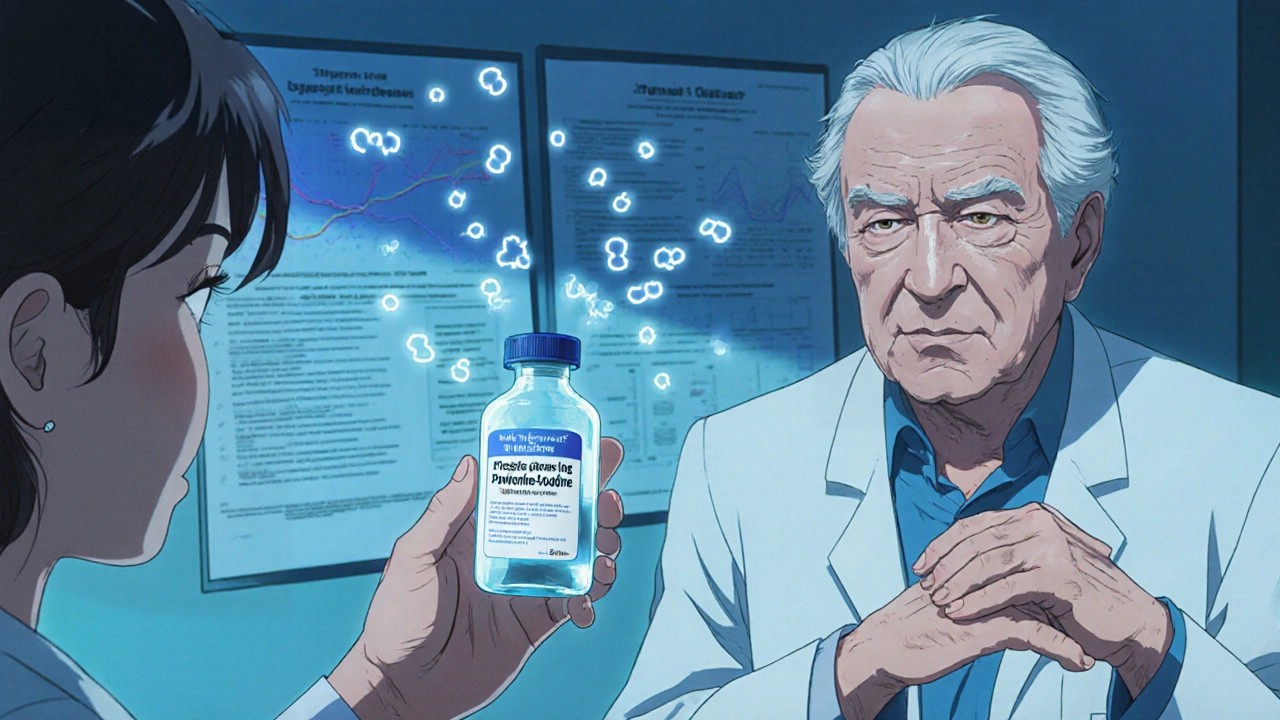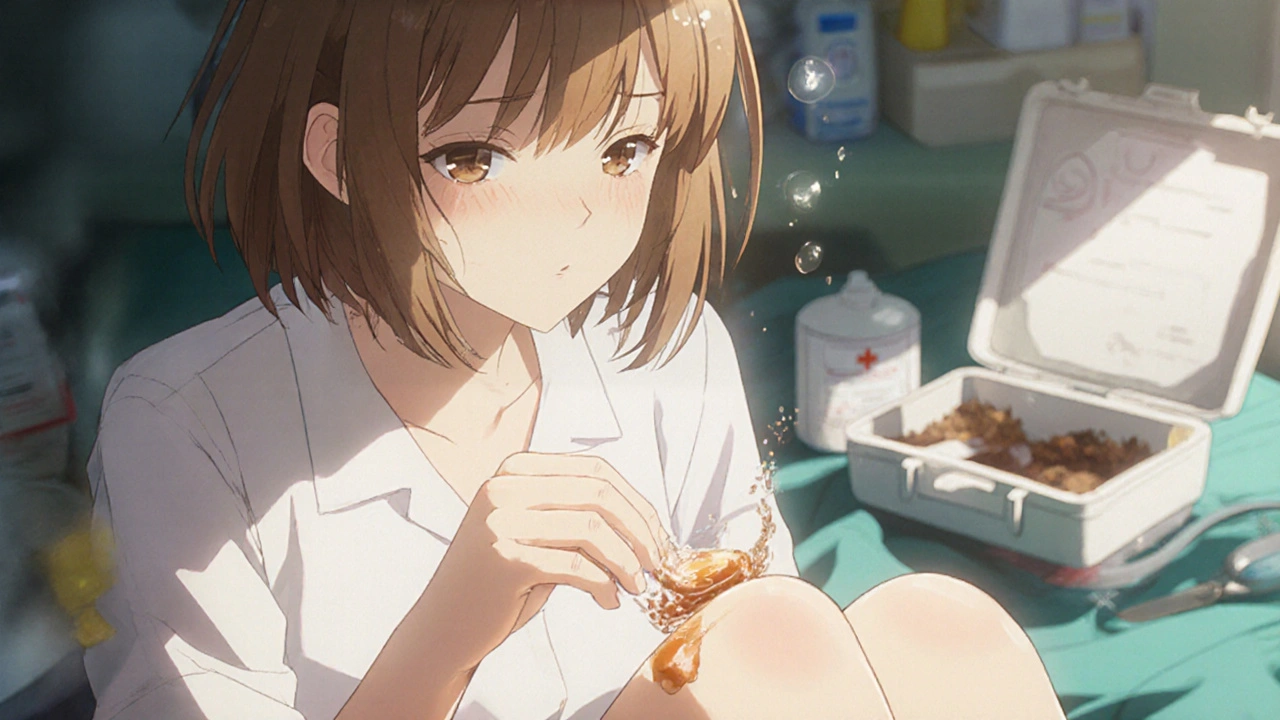People reach for povidone-iodine because it works fast. You’ve seen it in first aid kits, pharmacies, and even hospitals - that brown liquid that stings a little when you pour it on a cut. It’s cheap, widely available, and kills germs on contact. But how safe is it really? And what happens if you use it wrong? Many assume it’s harmless because it’s been around for decades. That’s not always true.
What povidone-iodine actually is
Povidone-iodine is a complex made of iodine and a polymer called povidone. It slowly releases iodine onto the skin, which kills bacteria, viruses, and fungi. Unlike alcohol or hydrogen peroxide, it doesn’t burn tissue as harshly, which is why it’s used before surgeries, for wound cleaning, and even as a throat spray in some countries.
The active ingredient is iodine - the same element your thyroid needs to make hormones. But here’s the catch: your body only needs tiny amounts. Too much iodine, especially absorbed through broken skin or swallowed, can mess with your thyroid. That’s why it’s not just a simple antiseptic. It’s a potent chemical with real risks if misused.
Common side effects you might notice
Most people use povidone-iodine without issues. But side effects happen more often than you think. The most common is skin irritation. Redness, itching, or a mild burning feeling after application isn’t rare. If you have sensitive skin, eczema, or a history of allergic reactions, you’re more likely to react.
Some users report a metallic taste if the solution gets near the mouth - that’s iodine being absorbed. It’s not dangerous in small amounts, but if you’re swallowing it regularly (like from gargling too much), you could be taking in too much iodine over time.
Discoloration is another issue. Povidone-iodine stains skin, clothes, and even countertops. That brown color can last for days. It’s not harmful, but it’s messy and can look alarming if you don’t know what’s happening.
When povidone-iodine becomes dangerous
The real risks come from misuse. Using it inside the body - like in the nose, ears, eyes, or vagina - is not safe unless a doctor specifically says so. The mucous membranes absorb iodine too well, and that can lead to thyroid dysfunction.
In 2023, a case study from a Perth hospital reported a 68-year-old woman who developed hypothyroidism after using povidone-iodine nasal spray daily for three months to treat chronic sinusitis. Her iodine levels were sky-high. Once she stopped, her thyroid function returned to normal in six weeks. This isn’t an isolated case. Endocrinologists have seen a rise in iodine-induced thyroid issues linked to over-the-counter antiseptic misuse.
Swallowing even a small amount - say, a teaspoon - can cause nausea, vomiting, stomach pain, and in severe cases, kidney damage or metabolic acidosis. Children are especially at risk. There’s been a 40% increase in pediatric poison control calls involving povidone-iodine since 2020, mostly from accidental ingestion.

Who should avoid it entirely
You should not use povidone-iodine if you have:
- A known allergy to iodine or shellfish (yes, they’re linked - both contain iodine compounds)
- Thyroid disease like Hashimoto’s, Graves’ disease, or nodules
- Kidney problems - your body can’t clear excess iodine well
- Pregnancy or breastfeeding - iodine crosses the placenta and enters breast milk
- Infants under 6 months - their thyroid systems are too immature to handle extra iodine
If you’ve ever had a reaction to contrast dye during an X-ray or CT scan, you’re likely iodine-sensitive. Don’t assume it’s safe just because you’ve used it before. Sensitivity can develop over time.
Safe usage guidelines
There’s nothing wrong with povidone-iodine when used correctly. Here’s how to use it safely:
- Use it only on intact or lightly broken skin - never on deep wounds, burns, or large areas.
- Apply a thin layer. A few drops are enough. You don’t need to soak the area.
- Let it dry. Don’t rinse it off unless directed. The iodine needs time to work.
- Never use it in the eyes, ears, or inside the nose or mouth unless prescribed.
- Store it out of reach of children. Keep the cap tightly closed.
- Check the expiration date. Old solutions lose potency and can break down into harmful byproducts.
For minor cuts or scrapes, clean the area with water and soap first. Then use povidone-iodine as a final step - not as a replacement for proper wound care.
Alternatives that work just as well
You don’t need povidone-iodine for every cut. For small wounds, clean water and mild soap are often enough. If you want something stronger, consider:
- Chlorhexidine gluconate - less likely to cause allergic reactions, no iodine content, good for pre-surgical prep
- Isopropyl alcohol (70%) - fast-drying, good for skin before injections
- Hydrogen peroxide (3%) - okay for initial cleaning, but don’t use it long-term - it slows healing
Chlorhexidine is becoming the new standard in many hospitals because it’s gentler and doesn’t interfere with thyroid function. It’s also less likely to stain.

What to do if you have a bad reaction
If you develop swelling, hives, difficulty breathing, or a rash after using povidone-iodine, stop using it immediately and seek medical help. These are signs of a serious allergic reaction.
If you swallowed it - even a small amount - call your local poison control center. In Australia, that’s 13 11 26. Don’t wait for symptoms. Iodine poisoning can be delayed.
If you notice unexplained fatigue, weight gain, or cold intolerance after regular use, get your thyroid checked. A simple blood test for TSH and free T4 can tell you if your iodine intake has affected your thyroid.
Final thoughts
Povidone-iodine isn’t evil. It’s saved lives in operating rooms and field hospitals. But treating it like a magic cure-all is dangerous. It’s a powerful tool - not a harmless household item. The more you use it, the more you risk side effects, especially if you have underlying health conditions.
Respect it. Use it only when needed. And if you’re unsure, ask a pharmacist or doctor. There’s no shame in checking. Your thyroid doesn’t care how long you’ve used it - it just reacts to what’s in your body.
Can povidone-iodine cause thyroid problems?
Yes, especially with long-term or frequent use on large skin areas, in the nose, or if swallowed. Iodine is absorbed through the skin and mucous membranes, and excess iodine can suppress or overstimulate the thyroid gland. People with existing thyroid conditions, pregnant women, and infants are at higher risk. Cases of iodine-induced hypothyroidism have been documented in medical journals after routine nasal or wound use.
Is it safe to use povidone-iodine on open wounds?
It’s okay for small, superficial wounds like scrapes or minor cuts. But for deeper wounds, burns, or large areas, it can delay healing. The iodine kills not just bacteria but also healthy cells needed for tissue repair. Clean the wound with water and saline first, then use a small amount of povidone-iodine only if there’s visible dirt or infection risk. Avoid using it daily.
Can I use povidone-iodine as a mouthwash?
Some throat sprays contain diluted povidone-iodine and are approved for short-term use. But using the standard surgical solution as a mouthwash is not recommended. Swallowing even small amounts regularly can lead to iodine toxicity. It can also kill beneficial bacteria in your mouth, leading to fungal overgrowth like thrush. Use only products labeled for oral use and follow the instructions exactly.
Does povidone-iodine expire?
Yes. Most solutions last 2-3 years if unopened and stored away from light and heat. Once opened, the iodine slowly evaporates or breaks down. An expired solution may turn clear or pale yellow - that means it’s lost its potency. Using it won’t harm you, but it won’t kill germs either. Always check the expiration date and discard if the color has changed.
Is povidone-iodine safe for children?
For children over 6 months, it’s generally safe for small cuts or scrapes when used sparingly. Avoid using it on large areas, near the eyes or mouth, or for prolonged periods. Infants under 6 months should never use it - their thyroid systems are too sensitive. Always keep it out of reach. If a child swallows even a sip, contact poison control immediately.
Can I use povidone-iodine if I’m allergic to shellfish?
Yes - but with caution. Shellfish allergies are usually to proteins in the shellfish, not iodine. However, many people with shellfish allergies also have iodine sensitivity, and the risk of cross-reaction is higher. If you’ve ever had a reaction to iodine-based contrast dye during an X-ray, you should avoid povidone-iodine entirely. When in doubt, test a small patch of skin first or choose an alternative like chlorhexidine.
Why does povidone-iodine stain skin and clothes?
The brown color comes from elemental iodine binding to proteins in your skin and fabric. It’s not a dye - it’s a chemical reaction. The stain fades naturally over a few days as your skin sheds. For clothes, rinse immediately with cold water and use a stain remover. Hot water sets the stain. The discoloration is harmless but can be mistaken for bruising or infection.
What to do next
If you’ve been using povidone-iodine daily for acne, wound care, or nasal congestion, stop for a week and see how you feel. Fatigue, weight gain, or dry skin could be signs your thyroid is reacting. Talk to your doctor about a simple blood test.
Keep a bottle for emergencies - like a cut from gardening or a minor burn from cooking. But don’t let it become a daily habit. Your body doesn’t need extra iodine. In fact, too much does more harm than good.
